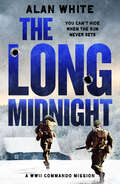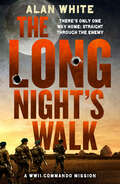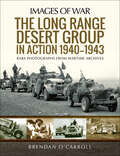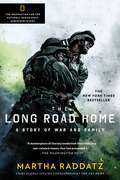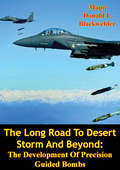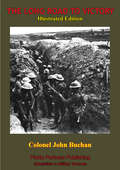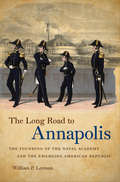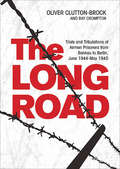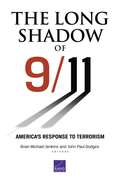- Table View
- List View
The Long Gray Line
by Rick AtkinsonBased on the true story of Marty Maher, a humble Irish immigrant who rose through the ranks to become one of West Point's most beloved instructors. A rousing tribute to a remarkable man & his way of life.
The Long Habit of Living
by Joe HaldemanMore even than space travel, the Stileman Process had altered twenty-first century life. The most complex of medical miracles, it ensured that every ten years or so, the ailing aging body could be restored to youthful vigour and health.There was a catch of course. The cost. Every ten years or so you have to come up with £1,000,000 minimum or die.For Dallas Barr, one of the oldest men on earth, it was that time again. It was while he was casting around for that vital next million that he came across Maria, a woman from - literally - a previous life. And made two major discoveries.Not all Stileman 'immortals' were born - or created - the same. And someone is trying to kill them. All of them.
The Long Left Flank: The Hard Fought Way to the Reich, 1944–1945
by Jeffery WilliamsWhen in August, 1944, the Allies broke out of Normandy, the world's attention became fixed on the dramatic British and American armoured thrusts into the Rhine. The war in Europe seemed all but over. Far to the left, along the flank of the Allied Expeditionary Force, almost unnoticed, a battle was beginning on whose outcome hung not only victory but the possibility of disaster Under-strength, neglected by Montogomery and denied by Eisenhower the supposed which he had promised, First Canadian Army paid an appalling price in casualties to clear the Channel coast and open up the great port of Antwerp. Commanded by General Harry Crerar , the army contained not only Canadians, but, for most of the campaign, more British troops then the Eighth Army at Alamein. Poles, Americans, Dutch, Belgians, Czechs and French served in it and were partnered in all their operations by the equally international No.84 Group, RAF. Their hard-won success in clearing the banks of the Scheldt and in capturing Walcheren Island was followed four months later by victory in the Rhineland. There, with almost every one of Montgomery's British Divisions under command, they smashed the best of what remained of the German Army and, with it, Hitler's last hope of defending the Rhine. The way was open for the Allies into the heart of the Reich. In the war's final phase, most of Crerar's British divisions were replaced with by Canadian formations newly arrived from their arduous campaign in Italy. Striking north and west after crossing the Rhine, they liberated Holland and drove east-ward into the heavily defended area of Germany. At war's end they had reached the Weser and were closing on the great naval bases of Emden and Wilhemshaven. Jeffery Williams won wide acclaim for his definitive biography Viscount Byng of Vimy. He brings the same assured touch to this lively and fast-moving account of a crucial aspect of the battle for North-West Europe which has hitherto been largely neglected by historians.
The Long March (Virago Modern Classics)
by William StyronThe author of Sophie&’s Choice, &“the foremost writer of his generation,&” portrays a rebellion by two marines on a miles-long march in the Carolina heat (The Wall Street Journal).In the shadow of the Korean War, a series of misfired mortar shells kill six men in a marine camp during a training exercise, prompting the commanding officer to order a grueling punishment: a thirty-six mile march through the suffocating heat of the Carolina summer. Intended to beat discipline into the aging reservists, the march instead rankles marines Culver and Mannix, whose growing resentment of the brutal trek leads to an ultimate, powerful act of rebellion. Styron&’s The Long March is a withering critique of a military system that leaves no room for dignity or personal identity. Told in part through flashbacks and dream sequences, the story is immersed in vivid language and philosophical reflection—a poignant defense of the individual in the face of attempted dehumanization. This short novel marks another triumph by the New York Times–bestselling author of Sophie's Choice and Darkness Visible, who has been honored with both a Pulitzer Prize and a National Book Award, among other accolades. This ebook features a new illustrated biography of William Styron, including original letters, rare photos, and never-before-seen documents from the Styron family and the Duke University Archives.
The Long March, and In the Clap Shack
by William StyronIn The Long March, two Marine reservists fight to maintain their dignity while on a hard exercise staged by a posturing colonel. In the Clap Shack maps the terrified passage of a young recruit through the prurient inferno of a Navy hospital VD ward.
The Long Masquerade
by Madeleine BrentIn 1897 a small ship sails the Caribbean, trading between the islands. It is the home of a man and girl, runaways wanted for murder and who live in fear of arrest. Casey had once been Emma Delaney, wife of Oliver Foy and mistress of Diablo Hall, one of Jamaica's great houses. A devil had dwelt within Diablo Hall, a devil who meant to break her to his will. When Emma escapes that sinister marriage she wanders across the seas learning the skills that she now depends on. Her life as Casey comes to an end when she is brought penniless to England, where she must face the man who possesses the "evil eye," and when she finds love it brings new danger and an agonizing choice.
The Long Midnight (The WW2 Commando Missions)
by Alan White&“The action gets hot on the icy fjords&” in this gripping novel of two British commandos in World War II Norway (Kirkus Reviews). Norway, 1943. A land in the grip of Nazi occupation, where men and women still fight for freedom in constant danger from German murder squads and Norwegian traitors. It is to find such a traitor that two men are sent from Britain. Their mission is twofold. First, to expose—and kill—the traitor. Second, to carry out a brilliant and daring operation of rescue and sabotage. And you can&’t hide when the sun never sets . . . Praise for the series &“Tense and convincing.&” —The Observer &“I think it&’s the best thing of its kind I&’ve ever read. I literally couldn&’t put it down.&” —Leslie Charteris, author of The Saint novels &“A gripping read.&”—The Sunday Times
The Long Mirage (Star Trek: Deep Space Nine)
by David R. George IIIContinuing the post-television Deep Space Nine saga comes this thrilling original novel from New York Times bestselling author David R. George III!More than two years have passed since the destruction of the original Deep Space 9. In that time, a brand-new, state-of-the-art starbase has replaced it, commanded by Captain Ro Laren, still the crew and residents of the former station continue to experience the repercussions of its loss. For instance: Quark continues his search for Morn, as the Lurian—his best customer and friend—left Bajor without a word and never returned. Quark enlists a private detective to track Morn down, and she claims to be hot on his trail. Yet the barkeep distrusts the woman he hired, and his suspicions skyrocket when she too suddenly vanishes. At the same time, Kira Nerys emerges from a wormhole after being caught inside it when it collapsed two years earlier. She arrives on the new DS9 to discover Altek Dans already there. While inside the Celestial Temple, Kira lived a different life in Bajor&’s past, where she fell in love with Altek. So why have the Prophets moved him forward in time…and why have They brought him and Kira together? ™, ®, & © 2016 CBS Studios, Inc. STAR TREK and related marks and logos are trademarks of CBS Studios, Inc. All Rights Reserved.
The Long Night (Star Trek: Deep Space Nine #14)
by Kristine Kathryn Rusch Dean Wesley SmithCenturies ago, the Supreme Ruler of the planet Jibet fled a democratic uprising, taking with him many priceless works of art. Now Quark's greed leads Commander Sisko and his crew to the lost treasures -- and to the Supreme Ruler himself, preserved in cryogenic suspension. The discovery sparks unrest on Jibet, and launches an alien armada against Deep Space Nine . As Dr. Bashir struggles to keep the dying ruler alive, Jake and Nog uncover deadly evidence of lingering Cardassian treachery. Now, Sisko must somehow keep the mysteries of the past from destroying all hope for DS9's future.
The Long Night's Walk (The WW2 Commando Missions)
by Alan WhiteThere&’s only one way home: straight through the enemy . . . An action-packed WWII tale filled with &“snappy authenticity&” (Kirkus Reviews). Four British commandos parachute into occupied Holland. Their mission: to delay and impede German communications long enough to cover the escape of an Allied unit a few miles away. Soon the countryside is in chaos, and the whole German army is hunting for them. And if they miss the rendezvous with the plane sent to extract them, it&’s a long way home . . . The author of The Long Day&’s Dying returns with another tense, gripping story about a daring mission in Nazi-occupied Europe. &“White&’s technical knowledge is authoritative.&” —Kirkus Reviews
The Long Night: A Flandry Book
by Poul AndersonThe legendary Nicholas van Rijn had, of course, been right all along. Just as he had foreseen, the Polesotechnic League - that great empire of merchant princes - had flowered and then crumbled into the vastness of space.The same fate would befall the Terran Empire that succeeded it. Even heroes like Dominic Flandry lived under the shadow of their eventual extinction - the ever-hungry darkness that would take him and his world in the end.But for those who came after, those wretched heirs of Terran civilisation, the darkness was no impending tragedy. This time they were facing the reality of...THE LONG NIGHT
The Long November
by Walt GraggIn the tradition of Red Storm Rising and Red Metal, an American military force fights a desperate battle against an overwhelming enemy.What started as a military coup in Pakistan has ignited South Asia and threatens to spread to the world's largest democracy in India. American and British allies struggle to rescue Western civilians who have been cut off in Islamabad. What starts as a desperate race turns into a grim siege. But the fate of a few innocents pales in comparison to one inescapable fact: Pakistan is a nuclear power and some of those weapons are unaccounted for.
The Long Range Desert Group in Action 1940–1943: Rare Photographs From Wartime Archives (Images of War)
by Brendan O'CarrollThis first pictorial history of the LRDG &“covers all aspects of [its] work and the vehicles and weapons they used in their devastating raids&” (Beating Tsundoku). The Long Range Desert Group has a strong claim to the first Special Forces unit in the British Army. This superb illustrated history follows the LRDG from its July 1940 formation as the Long Range Patrol in North Africa, tasked with intelligence gathering, mapping and reconnaissance deep behind enemy lines. Manned initially by New Zealanders, in 1940 the unit became the LRDG with members drawn from British Guards and Yeomanry regiments and Rhodesians. So successful were the LRDG patrols, that when the Special Air Service was formed, it often relied on their navigational and tactical skills to achieve their missions. After victory in North Africa the LRDG relocated to Lebanon before being sent on the ill-fated mission to the Dodecanese Islands in the Aegean. Serving independently, when the Germans overwhelmed and captured the British garrisons, many LRDG personnel escaped using their well-honed skills. Many images in this, the first pictorial history of the LRDG, were taken unofficially by serving members. The result is a superb record of the LRDG&’s achievements, the personalities, their weapons and vehicles which will delight laymen and specialists alike. &“Well written . . . The photographs brought together here are a stunning selection despite the various quality as it shows the men and machines living the war they fought in.&”—Armorama &“A must-read page turner.&”—Richard Gough, military author and historian &“Informative and full of exciting detailed accounts of operations that occurred throughout the LRDG&’s reign of terror on the Axis forces during the war.&”—AMPS
The Long Range Desert Group in Action 1940–1943: Rare Photographs From Wartime Archives (Images of War)
by Brendan O'CarrollThis first pictorial history of the LRDG &“covers all aspects of [its] work and the vehicles and weapons they used in their devastating raids&” (Beating Tsundoku). The Long Range Desert Group has a strong claim to the first Special Forces unit in the British Army. This superb illustrated history follows the LRDG from its July 1940 formation as the Long Range Patrol in North Africa, tasked with intelligence gathering, mapping and reconnaissance deep behind enemy lines. Manned initially by New Zealanders, in 1940 the unit became the LRDG with members drawn from British Guards and Yeomanry regiments and Rhodesians. So successful were the LRDG patrols, that when the Special Air Service was formed, it often relied on their navigational and tactical skills to achieve their missions. After victory in North Africa the LRDG relocated to Lebanon before being sent on the ill-fated mission to the Dodecanese Islands in the Aegean. Serving independently, when the Germans overwhelmed and captured the British garrisons, many LRDG personnel escaped using their well-honed skills. Many images in this, the first pictorial history of the LRDG, were taken unofficially by serving members. The result is a superb record of the LRDG&’s achievements, the personalities, their weapons and vehicles which will delight laymen and specialists alike. &“Well written . . . The photographs brought together here are a stunning selection despite the various quality as it shows the men and machines living the war they fought in.&”—Armorama &“A must-read page turner.&”—Richard Gough, military author and historian &“Informative and full of exciting detailed accounts of operations that occurred throughout the LRDG&’s reign of terror on the Axis forces during the war.&”—AMPS
The Long Range Desert Group in the Aegean
by Brendan O'CarrollA history of the British Army unit’s deployment to and defense of a group of islands between Greece and Turkey during World War II.Shortly after the invasion of Sicily, in order to distract German attention from the Italian campaign, Churchill ordered the occupation of the Dodecanese Islands in the Aegean.The Long Range Desert Group, retraining in Lebanon, were now part of Raiding Forces, Middle East, along with the Special Boat Service and No 30 Commando. In support of 3,000 regulars in 234 Brigade, the LRDG landed covertly on Leros establishing observation posts, reporting movement of enemy shipping and aircraft.In October the LRDG were ordered to assault the island of Levitha, losing forty highly skilled men killed or captured. The Germans invaded Leros with overwhelming force on 12 November 1943, five days later the battle was over. While many British troops were captured most of the LRDG and SBS escaped. Their individual stories make for enthralling reading.A measure of the intensity of the fighting is the fact that the LRDG lost more men in three months in the Aegean than in three years in the desert operating behind enemy lines.The author, an acknowledged expert on the LRDG uses official sources, both British and German, and individual accounts to piece together the full story of this dramatic, costly but little-known campaign. It is a valuable addition to the history of special forces in the Second World War.Praise for The Long Range Desert Group in the Aegean“O’Carroll provides an interesting and informative read about a little known action by a World War II era special operations unit and an important part of SOF history.” —SOF News
The Long Range Desert Group, 1940–1945: Providence Their Guide
by David Lloyd-Owen&“A very engaging and fine tribute to a small band of men whose impact on the North African campaign in particular was quite immense.&” —Pegasus Archive This splendid record takes the reader behind enemy lines not only in North Africa but in Italy, the Aegean and the Balkans. The author, who commanded the LRDG, paints a vivid picture of the unit&’s colorful characters: for example, Ralph Bagnold who put to good use the knowledge he gained from his pre-war desert travels. The LRDG was truly international with New Zealanders and Rhodesians playing key roles. This classic book won acclaim from the critics on its first publication by virtue of the author&’s unique knowledge, experience and narrative skills.&“This superb account, written by one of their former commanders, examines the formation of the unit, the very diverse personalities which shaped it, the North African operations, and their subsequent role in Italy and the Balkans . . . Filled with detailed descriptions of individual operations and the remarkable characters who carried them out.&” —Pegasus Archive
The Long Reckoning: A Story of War, Peace, and Redemption in Vietnam
by George BlackThe moving story of how a small group of people—including two Vietnam veterans—forced the U.S. government to take responsibility for the ongoing horrors—agent orange and unexploded munitions—inflicted on the Vietnamese."Fifty years after the last U.S. service member left Vietnam, the scars of that war remain...This [is the] remarkable story of a group of individuals determined to heal those enduring wounds.&”—Elliot Ackerman, author of The Fifth Act and 2034The American war in Vietnam has left many long-lasting scars that have not yet been sufficiently examined. The worst of them were inflicted in a tiny area bounded by the demilitarized zone between North and South Vietnam and the Ho Chi Minh Trail in neighboring Laos. That small region saw the most intense aerial bombing campaign in history, the massive use of toxic chemicals, and the heaviest casualties on both sides.In The Long Reckoning, George Black recounts the inspirational story of the small cast of characters—veterans, scientists, and Quaker-inspired pacifists, and their Vietnamese partners—who used their moral authority, scientific and political ingenuity, and sheer persistence to attempt to heal the horrors that were left in the wake of the military engagement in Southeast Asia. Their intersecting story is one of reconciliation and personal redemption, embedded in a vivid portrait of Vietnam today, with all its startling collisions between past and present, in which one-time mortal enemies, in the endless shape-shifting of geopolitics, have been transformed into close allies and partners.The Long Reckoning is being published on the fiftieth anniversary of the day the last American combat soldier left Vietnam.
The Long Road Home: A Story of War and Family
by Martha RaddatzThe First Cavalry Division came under surprise attack in Sadr City on April 4, 2004, now known as "Black Sunday." On the homefront, over 7,000 miles away, their families awaited the news for forty-eight hellish hours-expecting the worst. ABC News' chief correspondent Martha Raddatz shares remarkable tales of heroism, hope, and heartbreak.
The Long Road To Desert Storm And Beyond: The Development Of Precision Guided Bombs
by Major Donald I. BlackwelderThis paper examines the long development of precision guided bombs to show that the accuracy attained in Desert Storm was an evolution not a revolution in aerial warfare. This evolution continues and gives offensive airpower the advantage over the defense. Guided bomb development started during World War One with the "aerial torpedo". During World War Two the German Fritz X and Hs-293 were visually guided bombs and both experienced success against allied shipping. The Army Air Corps also developed a wide variety of TV, heat, radar, and visually guided bombs. The visually guided AZON was successful in Burma and the radar guided Bat was successful against Japanese ships. During the Korean War visually guided RAZON and TARZON bombs had some success. In Vietnam the Paveway I laser-guided bombs and Walleye TV-guided bombs were successful on a much broader scale. Paveway II and III, Walleye II, and GBU-15s were developed and successfully combat tested throughout the 1970s and 1980s. When Desert Storm initiated in 1991 there were very few guided weapons that had not been extensively tested on training ranges and in combat. The precision demonstrated to the World during Desert Storm started evolving when airpower was first envisioned as a new dimension for conducting war, and was far from a revolution. Now, the continued development of imaging infrared, laser radar, synthetic aperture radar, and millimeter wave radar autonomous seekers further increases the flexibility, range, and effectiveness of guided bombs.
The Long Road To Victory [Illustrated Edition]
by Colonel John Buchan[Illustrated with 10 plates of the battles and engagements detailed in the book]Colonel John Buchan, was a man of many talents, a politician of upright morals and forthright character, a novelist of great acclaim and a soldier who served with distinction in the First World War. He collected stories and anecdotes by the dozen, crafting the best and worthiest into this collection which spans the entire conflict. As he himself states in his introduction;"THIS is a book of soldiers' tales, told, for the most part, by those who took part in the events they record. They are drawn from many branches of service and from many countries; sometimes they are concerned with great and critical operations, but more often they deal with episodes and sideshows in the huge business of war...There has never in the world's history been such an arena of drama and strange adventure as that long road which the Allies travelled to victory. Libraries will not exhaust its treasures; indeed, it will be years before we, who have 'been preoccupied with special stages, will be able to grasp the wonders of the whole journey. This budget of wayside tales is only the cutting of a few sheaves at random from an immense harvest."As the chapter headings confirm the war on the ground and in the air throughout the conflict has been sketched with aplomb, from pilots above the Somme to the deserts of North Africa I. - FIRST YPRES, 1914: THE TURNING OF THE TIDE. II. -"'TWIXT GUY FAWKES' AND ST. PATRICK'S." III. THE "PETROL HUSSARS." IV. - THE WORST AND THE BEST. V. - THE FIFTEENTH DIVISION AT LOOS. VI. - THE FIGHTING IN THE AIR DURING THE BATTLE OF THE SOMME. VII. - THE CALL. THE TALE OF A TANK. VIII. - THE TANKS AT CAMBRAI. IX. - CUT OFF IN A CAVE. - THE TALE OF A FIGHT BEYOND THE JORDAN. X. -THE SOUTH AFRICANS AT MARRIÈRES WOOD. XI. - ZEEBRUGGE-H.M.S. VINDICTIVE. XII. - THE RIVER COLUMN IN NORTH RUSSIA. XIII. - A SNIPER'S DAY. IV. - THE CAT. XIV. - "BUNKING.".
The Long Road to Annapolis
by William P. LeemanThe United States established an academy for educating future army officers at West Point in 1802. Why, then, did it take this maritime nation forty-three more years to create a similar school for the navy?The Long Road to Annapolisexamines the origins of the United States Naval Academy and the national debate that led to its founding. Americans early on looked with suspicion upon professional military officers, fearing that a standing military establishment would become too powerful, entrenched, or dangerous to republican ideals. Tracing debates about the nature of the nation, class identity, and partisan politics, William P. Leeman explains how the country's reluctance to establish a national naval academy gradually evolved into support for the idea. The United States Naval Academy was finally established in 1845, when most Americans felt it would provide be the best educational environment for producing officers and gentlemen who could defend the United States at sea, serve American interests abroad, and contribute to the nation's mission of economic, scientific, and moral progress. Considering the development of the naval officer corps in relation to American notions of democracy and aristocracy,The Long Road to Annapolissheds new light on the often competing ways Americans perceived their navy and their nation during the first half of the nineteenth century. The United States established an academy for educating future army officers at West Point in 1802. Why, then, did it take this maritime nation forty-three more years to create a similar school for the navy?The Long Road to Annapolisexamines the origins of the United States Naval Academy and the national debate that led to its founding. Americans early on looked with suspicion upon professional military officers, fearing that a standing military establishment would become too powerful, entrenched, or dangerous to republican ideals. Tracing debates about the nature of the nation, class identity, and partisan politics, William P. Leeman explains how the country's reluctance to establish a national naval academy gradually evolved into support for the idea. The United States Naval Academy was finally established in 1845, when most Americans felt it would provide be the best educational environment for producing officers and gentlemen who could defend the United States at sea, serve American interests abroad, and contribute to the nation's mission of economic, scientific, and moral progress. Considering the development of the naval officer corps in relation to American notions of democracy and aristocracy,The Long Road to Annapolissheds new light on the often competing ways Americans perceived their navy and their nation during the first half of the nineteenth century.
The Long Road to Baghdad: A History of U.S. Foreign Policy from the 1970s to the Present
by Lloyd C. GardnerThe diplomatic historian examines the ideas, policies and actions that led from Vietnam to the Iraq War and America&’s disastrous role in the Middle East. &“What will stand out one day is not George W. Bush&’s uniqueness but the continuum from the Carter doctrine to &‘shock and awe&’ in 2003.&” —from The Long Road to Baghdad In this revealing narrative of America&’s path to its &“new longest war,&” one of the nation&’s premier diplomatic historians excavates the deep historical roots of the US misadventure in Iraq. Lloyd Gardner&’s sweeping and authoritative narrative places the Iraq War in the context of US foreign policy since Vietnam, casting the conflict as a chapter in a much broader story—in sharp contrast to the dominant narrative, which focus almost exclusively on the actions of the Bush Administration in the months leading up to the invasion. Gardner illuminates a vital historical thread connecting Walt Whitman Rostow&’s defense of US intervention in Southeast Asia, Zbigniew Brzezinski&’s attempts to project American power into the &“arc of crisis&” (with Iran at its center), and the efforts of two Bush administrations, in separate Iraq wars, to establish a &“landing zone&” in that critically important region. Far more disturbing than a simple conspiracy to secure oil, Gardner&’s account explains the Iraq War as the necessary outcome of a half-century of doomed US policies. &“A vital primer to the slow-motion conflagration of American foreign policy.&” —Kirkus Reviews
The Long Road: A Postapocalyptic Novel (New World Series #2)
by G. Michael HopfThe End was just the beginning of the new world...<P><P> Only six weeks have passed since a super-EMP attack devastated the United States, but already, life has changed dramatically. Most of America has become a wasteland filled with starving bands of people, mobs and gangs. Millions are dead and millions more are suffering, with no end in sight.<P> For Gordon, Samantha, Sebastian, Cruz and Barone, the turmoil and chaos they dealt with in the early weeks after the attack will seem trivial in comparison to the collapse of society that plays out before their eyes. Uncertainty abounds as they all travel different paths in search of a safe place to call home. The only thing that is definite is that The Long Road will take its toll on all of them.<P> For readers of Going Home by A. American, Lights Out by David Crawford, Lucifer's Hammer by Jerry Pournelle and One Second After by William Forstchen
The Long Road: Trials and Tribulations of Airmen Prisoners from Bankau to Berlin, June 1944–May 1945 (Bankau)
by Oliver Clutton-Brock Raymond CromptonA history of the airmen imprisoned in Nazi Germany&’s largest World War II prisoner-of-war camp, the notorious Stalag Luft 7. This book is firstly a testament to those of many nationalities who found themselves imprisoned at Stalag Luft VII, Bankau (Luft 7 for short) in Upper Silesia, the Luftwaffe&’s last prisoner of war camp. Having survived the trauma of action against, and capture by, the enemy, some as far back as 1940, they came from France, the Low Countries, Germany, Norway, Denmark, Poland, the Balkans, Italy, Hungary, the Mediterranean and other seas, and from North Africa. Many of their experiences and adventures have never been documented before. It is also the complete history of their prisoner of war (POW) camp, Luft 7, told in full detail for the first time, a camp that existed for barely thirty-two weeks from its opening in early June 1944 to its closure in mid-January 1945.
The Long Shadow of 9/11
by Brian Michael Jenkins John Paul GodgesThis book provides an array of answers to the question, In the ten years since the 9/11 attacks, how has America responded? In a series of essays, RAND authors lend a farsighted perspective to the national dialogue on 9/11's legacy; assess the military, political, fiscal, social, cultural, psychological, and moral implications of U.S. policymaking since 9/11; and suggest options for effectively dealing with the terrorist threat in the future.






